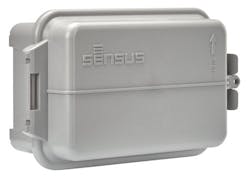Solving the Water Loss Equation With Smart Solutions
About the author:
Dan Pinney is vice president of global water product management for Sensus, a Xylem brand. Pinney can be reached at [email protected].
Life would be a lot easier if every problem were as simple as 2+2=4. However, anyone who made it through high school math knows it is not always that straightforward. While basic addition and subtraction might not require much thought, problems in non-linear algebra require an understanding of multiple factors to arrive at the correct answer.
In the system of equations utilities must manage, water loss is more like algebra than simple arithmetic. Utilities must factor in customer demands, weather, topography, aging infrastructure and other variables. Building a strategy that successfully considers each component can help utilities arrive at the correct solution.
The right technology is a key factor in working through the complexity of water loss challenges. For Big Sky, Montana, the deployment of a smart utility network helped kick start its strategy to improve leak detection and pressure monitoring.
Big Sky Begins Making Strides
Big Sky attracts skiers, mountain bikers and nature lovers to the Rocky Mountains. The gateway community to Yellowstone National Park has become a hot spot for seasonal residents and visitors who come from all over the country for breathtaking views and an abundance of outdoor recreation.
“As the community water utility, we’re probably the closest thing there is to a town government here,” said Ron Edwards, Big Sky Water & Sewer District general manager. “We might be a small community, but that doesn’t mean we’re not expected to provide service worthy of the name ‘Big Sky’.”
Big Sky Water & Sewer District aims to deliver a five-star experience for its 2,800 customers on par with any major resort town in the country. Their drive for excellence and enthusiasm for innovative technology puts it well on its way.
Getting Smarter
Monitoring water systems can be difficult in a community like Big Sky with a large seasonal population, extreme weather and elevation changes. Leaks and other issues may occur in residences when no one is there to notice. The district also bills quarterly, which makes finding problems early on even more critical for customers.
“Costs can really add up if a leak goes undetected for long,” said Edwards. “We need to be able to identify these types of things before they become big problems for customers or lead to non-revenue water issues.”
Edwards and his staff envisioned a virtual metering program that would allow the utility to aggregate meter data and better pinpoint where water is flowing. The utility deployed a smart utility network from Sensus, a Xylem brand, to provide remote system monitoring that yields advanced leak detection and quick response to customer needs.
A Big Impact
Big Sky’s technology investment combined iPERL residential water meters with the two-way FlexNet communication network and Sensus Analytics to bring in reliable, near-real-time data from across its service area. The system promptly validated its potential when it helped technicians spot a pumped sewer service line backup that caused a 170-gallon-per-hour leak at
one home.
“We connected with the customer and resolved the issue within a day,” Edwards said. “Of course the homeowner was thankful to avoid the cost and potential damage that could have come with a prolonged leak.”
In another instance, the team detected when underground lines froze beneath a condominium, a frequent occurrence in this renowned ski resort town. Workers had to wait until spring to fix the service line and instructed the homeowner to allow a trickle of water from one sink.
“We dispatched technicians with steam machines to help thaw the pipes before the situation could escalate,” Edwards said. “Without our network, we would not have had the information to respond so proactively or adjust the water bill accurately.”
Relieving Pressure
Elevation helps form quality ski slopes in Big Sky, but it also makes monitoring water pressure important as flow moves from high to low altitude. As an extension of the technology-driven system, the utility deployed the Sensus Smart Gateway Sensor Interface to monitor distribution across the district’s 10 pressure reducing valve (PRV) sites. The battery-powered Smart Gateway is a FlexNet-enabled device that connects to a variety of applications in locations where no power or land-based communications are available.
“We’ve installed the gateway devices at three sites so far and are already experiencing benefits,” Edwards said. “The ability to see and manage the water pressure coming through these sites allows us to better understand where we may have service area leaks.”
The network and software also allows the district to virtually group meters and quickly see daily water demand below the PRV vaults. Each PRV is individually metered and virtually grouping the meters below it for a targeted service area gives the utility the ability to narrow leak detection efforts.
Big Sky Water & Sewer District understands the role it plays in preserving resources as a utility governed by Western water rights law. Edwards said the smart infrastructure is a major asset to improve water loss reduction.
“One day we’ll be able to adjust the pressure so it’s not as high during non-peak nighttime hours,” Edwards said. “Having the right technology allows us to add these types of applications, which will only increase our level of control down the road.”
The Future is Wide Open
Big Sky’s team now has a virtual database to collect and organize the network data. The information helps utility workers counsel local customers.
“We have irrigation customers and hotels that are itching for insights,” Edwards said. “We can run the analysis for them right down to their hourly usage so they can get smarter with their own water goals.”
Whether the district is overseeing meter data or consulting with customers, the technology investment will continue to be instrumental in its smart water journey.
“We call the Xylem system our Swiss Army knife,” Edwards said. “It gives us a full range of tools with many purposes to help us best serve our customers.”
Final Grades
There’s a reason why teachers require students to show their work when it comes to solving complex math problems. Finding the right solution takes step-by-step thinking and the same holds true for utilities addressing water loss challenges.
As Big Sky’s example shows, utilities can measure incremental improvements aligned with their water loss goals and ensure they are prepared to ace the test with a solid strategic framework backed by the right digital technology solutions.


